Written by Laurie Ray, MPT, PhD, who has over 18 years of experience in school-based practice and is a state-level PT consultant for public schools. She also consults for Medicaid and Adapted Physical Education for her state and is an Associate Professor at UNC-Chapel Hill. Laurie also teaches continuing education via Apply EBP. More about these courses after the article below.
[smbtoolbar]
Here we go SeekFreaks… the beginning of the school year! A complex emotional experience that includes: anticipation, anxiety, hope, excitement, fear, nostalgia and joy. We thought it might be helpful to have a post devoted to getting our documentation act together early in the year. Please find here a listing of documentation options to consider setting up now so that all is prepped and ready when our students come flooding in!
This is a lot to consider! What of these listed suggestions will promote your clinical reasoning? Increase your efficiency? Prompt important details?
We do NOT suggest employing any form as a solo enterprise. Often districts or LEAs have templates and forms in place, check with your central office first. No need to recreate the wheel, although you may want to tweak it for your own needs! All developed forms should be shared with anyone who will use it for review, AND THEN with your supervisors and administrators for approval. Forms or templates with legal or liability implications should be vetted by your school board attorney.
Here we go! Note that we divided the documentation tools into 4 categories:
- FOR YOU: Organization
- FOR STUDENTS: IEP Documentation
- FOR ALL: Communication
- FOR PEACE OF MIND: License and Liability
Documentation Basics in Green, Extra Credits in Orange
~~~~~~~~~~ 0 ~~~~~~~~~~
FOR YOU: Organization
1. Workload
Excel is an excellent program to compile this information if you have access to it. It allows you to sort by last name or school or grade or whatever you organize in your little happy boxes. Want an online option? Try Google Sheets. It’s essentially an online version of Excel that you can access on any computer or mobile device with internet access.
- For each student you intervene with, your workload document should include:
- last name, first name,
- school assignment,
- date of birth,
- current grade,
- current dosage (frequency/duration),
- IEP due date,
- re-eval due date,
- precautions,
- current equipment-marked ‘personal’ or ‘classroom’
2. Monthly Schedule
It is a good idea to begin with any students who must be seen during specific school routine or activity, and build your schedule out from there. I liked to front load my month; getting less frequent interventions (e.g., monthly services) done in the first two weeks and then having room for unexpected evaluations, site visits and follow up communications, etc. in the last two weeks.
3. To Do List
Much of a school therapist’s day is packed: intervening with students, consulting with staff and running from school to school. There are also other tasks that are infrequent and can slip off the radar. To prevent this, a to do list can be helpful. It can be divided into schools you cover, type of task or team to track longer term projects, or once and done tasks.
4. Monthly Stats
Keeping data on your own practice can be helpful in a number of ways. It can help you reflect on your work, identify any patterns that may need changing, promote equity of work assignments, support the need for additional staffing, and defend productivity. Collecting data can be persuasive to administrators and provide insight into our work and work days as school therapists. Helpful data can include:
- school
- special education category
- age
- diagnosis
- average # of students on workload
- # of evaluations
- # of re-evaluations
- # of students added to workload
- # of students exited
- # of IEP meetings
- Letters of Medical Necessity
- # of consultations
- # of IEP placement mtgs
- # of transition plans
- # of intervention sessions
- # of missed sessions
- # of elementary, middle & high students
- # of sites visited
5. Mileage Tracker
Travel is an essential part of our work. Get reimbursed for the mileage you accrue in a timely manner by keeping track as you go. Don’t wait till the end of the month!
6. Service tracker cover page (with student info brief or detailed):
- grid to indicate date and record
- I=intervention provided
- A=student absent
- TA=therapist absent
- E=evaluation
- n/a=student not available
- tn/a=therapist not available
- IEP=annual IEP meeting
~~~~~~~~~~ 0 ~~~~~~~~~~
FOR STUDENTS: IEP documentation
7. Intervention Notes, Session Notes or Treatment Notes
This is the critical element of our work. These notes record our efforts, convey our value, and communicate our interventions and assessments. This documentation helps us do our best work and protects us from ineffective practice and legal challenges. We strongly recommend you check your state licensure act for specific requirements and practice guideline recommendations for documentation of your interventions. Please check out these suggestions for what could/should be included on your notes template.
- Service dates, time in, time out
- Abbreviated version of all student goals requiring your intervention
- System (check boxes) to indicate which goal(s) were addressed in a session, and progress on goal(s)
- Narrative- the old, reliable SOAP note structure has not failed us yet!! Be certain to include not only what happened and student response, but also what you, as a therapist, did. Does this not capture why your license was required to obtain this outcome or student response?
- Plan- what’s next for this student, in this plan of care? Not just ‘continue OT’! Think of this as a mini to do list: Who do I need to talk to? Who do I need to check in with? What follow up is needed for generalization? Is there a goal that needs some attention?
- Signature with credential
8. Progress Note/Report Card Template
Check your state and local special education policy for any requirements for timing or content of progress notes. IDEA requires parents be informed on a regular basis on how their child is progressing on his/her IEP goals.
9. Blank Copies of ‘Incident Reports’ and Consent to Release Information
It is very helpful to have these on hand when you are in IEP meetings. You explain them and can get them signed while parents are there.
10. Template for Exit Summary
When students are no longer in need of your services, it can be helpful to describe why. Are they able to access his/her education? Are needs no longer educationally relevant? Is your expertise/licensed interventions no longer necessary? I would provide my contact information at the bottom of this form and explain that if their child started to struggle later on in the school year they could always contact me. Often parents resist exiting services because they have heard once a service is off an IEP, they cannot get it back. This document communicates that your service is based on educationally relevant need and may be needed again in the future.
11. Template for Graduating Student Summary (includes independent living, vocational and postsecondary education information)
Under IDEA, each student who graduates with an IEP must be provided a summary of his/her current academic and functional performance. Each school therapist working with the student should provide relevant information for this summary. Creating a template for pertinent information can expedite communicating this information to the case manager.
12. SAS and Semester Tasks Tracker
Supplementary aids and services, or in IDEA language ‘services on behalf of a student, are an excellent and underutilized way to provide needed services for students, especially those in general education. It is difficult to keep up with these intermittent services so it would be wise to have a way to track these services (such as, marking tie down spots for wheelchairs, evacuation training for staff, training staff for transfers, consulting staff to include movement into class/instruction, etc.).
13. Evaluation Templates
Some therapists find it helpful to develop evaluation templates organized according to a specific standardized evaluation, like the School Function Assessment, among others. Or templates can be created for a general age, type of evaluation, identified focus areas or diagnoses.
14. Standardized Assessment Forms and Score Sheets
Create a folder of standardized assessments that you typically perform when conducting an evaluation. Some of them, such as the Pediatric Balance Scale and the Pediatric Reach Tests have score sheets and instructions that you need to utilize. Print some copies so you are always ready to evaluate. You can find some of these score sheets in our lists of top balance, walking and wheelchair operation tests to find copies of score sheets. {links}
~~~~~~~~~~ 0 ~~~~~~~~~~
FOR ALL: Communication
15. Communication Log
I found this as an invaluable aid for my atrocious memory. This was a simple chart where I recorded the date and time of the call or conversation, notes from the exchange, who I was speaking with, and follow up tasks including who is responsible for what. I also printed out emails that were important and archive them with these logs.
16. Start-of-School Introduction Letter(for parents/guardians & teachers)
At the beginning of each school year or when I received a new student I sent a standard letter to both the parents and the teachers whom I did not know or know well. I introduced myself, provided contact information, gave an extremely abbreviated description of my role and when I intended to provide therapy to this student/tentative schedule.
17. Student Info
It is good to have complete student information on hand. This can be stored separately, as a part of the service tracker, or as part of a workload roster. Information to consider keeping in addition to the data points mentioned above in the workload: Medicaid #, special education category, diagnosis(es), primary physician, specialty physician, community/outpatient therapists, parents names, home address, home & work phone, communication preference for parents (text, email phone), preferred equipment vendor, personal and/or assigned equipment/orthotics, any notes on family, culture, social aspects, notes on diagnoses, performance or other key details.
18. Parent Survey
This is how I obtained or confirmed much of the information above. I sent this survey out with the start of school letter. I also inquired as to any changes that occurred over the summer: physical, emotional, medical, developmental or otherwise.
19. Transportation Checklist
This form communicates expectations and specific details regarding transportation needs (e.g. wheelchair positioning, communication needs) and/or conveys health (e.g. how to handle seizures) or behavior (how pain is expressed, effective calming techniques) to transportation staff.
20. School Assignment Checklist
When students transition to a different school, this form expedites accommodating individual needs for equipment, storage, sensory diets, bathroom access, communication needs, staffing or adult assistance, campus access/accommodations, evacuation needs, meal preparation needs, health information or precautions, etc.
21. Reminder Template for Delegated Tasks (such as positioning, sensory experience, communication, practice of skills, etc.)
Having a tangible reminder for staff in the classroom with photos, routine suggestions (when is the best time for x intervention) and tips can improve fidelity of practice within the school day.
22. Peer Involvement/Delegated task (similar to #21 but geared for quick understanding by peer helper or buddy)
This documents instruction for peers for specific work with a student as well as tasks delegated to staff, helpful suggestions and reminder for implementation and fidelity. Make sure these are quick to read and on an appropriate language level for the peer. For example:
- Laurie likes music when you walk with her for exercise.
- Please remind her to keep her ‘eyes on her path’ if she stumbles.
- Don’t pull her walker for her.
- Try to walk for 5 minutes without stopping.
OR Carlo needs help to take more than 2 turns in a conversation that is not about dinosaurs. Try to help him to ask questions and remind him to ‘look at the friend’s face’.
23. Communication Template for Community Colleagues, MDs, Vendors, etc.
Templates for correspondence that are common in our practice: requests for information, provision of information for consideration of pending decisions.
24. Template for Meeting Notes
Don’t just use scratch papers that you may lose later on. Create a template for meetings such as IEPs, staff meetings, professional development and training sessions. This template may include meeting discussions, plan of action, and deadlines.
~~~~~~~~~~ 0 ~~~~~~~~~~
FOR PEACE OF MIND: License & Liability
25. Plan of Care (PoC) or Intervention Plan
This is usually required by our licensure. What is your plan for intervening with this student? It should be developed after the IEP and updated throughout the year as appropriate. While the IEP contains some needed elements of a PoC, student goals and service delivery details, it does not describe the intervention approach and clinical reasoning of the therapist. A PoC can refer to the IEP for some details or repeat them in the PoC document. For a complete PoC, please consider these components for your plan template:
-
- Medical diagnosis, discipline specific diagnosis and prognosis if possible
- Goals stated in measurable terms, the IEP has the student goals. Are there impairment level goals you need to track or other goals not included in the IEP? Are there long term goals you need to establish?
- Clinical approaches, frameworks of reference or other clinical theories you plan to employ
- Planned interventions, type of interventions- it is nice to list in chronological order or if deeper assessment needed to determine what issue or system underlies the functional performance, then list interventions you will attempt in prioritized order. Also, distinguish interventions to be provided by a PTA or interventions delegated to staff.
- Proposed duration and frequency of service required to reach the goals and any anticipated adjustments to dosage (can refer to IEP for detail). Include any clinical reasoning or data that service delivery recommendations. Notes on supplementary aides and services.
- Location of service provision- with whom, where and why
- Clarify clinical reasoning for interventions, approach, goals or services delivery choices
- Include any additional pertinent information (behavior approaches, lessons learned, interests, preferences, family status, social details, long term student goals, etc.)
- Extra curricular activities, Community or outpatient therapy goals, notes on staff
- Equipment or accommodations
- Anticipated discharge plans
- Dated and signed by practitioner with professional credential (CCC-SLP, OTR/L, PT, MPT, etc.)
For a more detailed discussion on Plan of Care read the article IEP 4.0 – Creating an Intentional Plan of Care.
26. Delegated Task Training Documentation (communication, transportation, skill practice, transfers, positioning, etc.)
Documenting appropriate training, monitoring and supervision of task that are delegated to staff is very important. While rarely needed, when proof is required to verify training was conducted you will be very happy to have it! Include the date, who was trained, what training occurred, any questions answered, demonstrations returned, monitoring plan and signatures of all concerned.
27. Equipment Loan Agreement
When equipment needs to be loaned to the student/family to ensure FAPE, it is helpful to clarify expectations regarding the equipment, maintenance and condition of return. This can be a contract that also provides information as to what to do/procedures to respond to anticipated problems or issues. Obtaining a school district attorney’s review would be important for this document.
28. Equipment Loan Liability Waiver
A document that waives liability if loaned equipment is misused, damaged or any harm occurs. This is one that will require an attorney’s vetting.
29. Monthly Planner (for seasonal or monthly reminders)
This can be a catch all for tasks outside of typical routine. The to do list or SAS task tracker could be combined into this planner. It can be helpful for a monthly review at the beginning or end of the month.
30. Professional Development Plan &/or Record
At the time you need to input your continuing education, having this record in one place can be a delight. Consider including dates, times/contact hours/CEUs, title, speakers, location and cost.
31. Safety Equipment or Procedure
A template for communicating information or documenting training for protective or safety equipment or procedures (e.g. unique needs for a feeding or mealtime procedure, when to use a helmet and why, Epi Pen locations and procedures, evacuation procedures with wheelchair).
32. Photo and Video Release
A photo release is great to have on hand, especially at IEP meetings. It is helpful to have permission to collect and use photographs and videos of students for instructional purposes, communicating progress, demonstrating interventions, etc.
~~~~~~~~~~ 0 ~~~~~~~~~~
Seeking Your Views
Other ideas? What has been helpful in your practice? Please use the comments section to add your ideas and descriptions for other documentation helps!
~~~~~~~~~~ 0 ~~~~~~~~~~
Readers of this article also read:
10 Handy American Speech-Language-Hearing Association Resources
Top 10 Walking Tests for School-based PTs
The 4 Cs of Letters of Medical Necessity that Gets Equipment Funded
IEP 4.0 – Using Data and Collaboration to Develop a Clear PLEP
Catch the author, Laurie Ray in her Apply EBP webinars
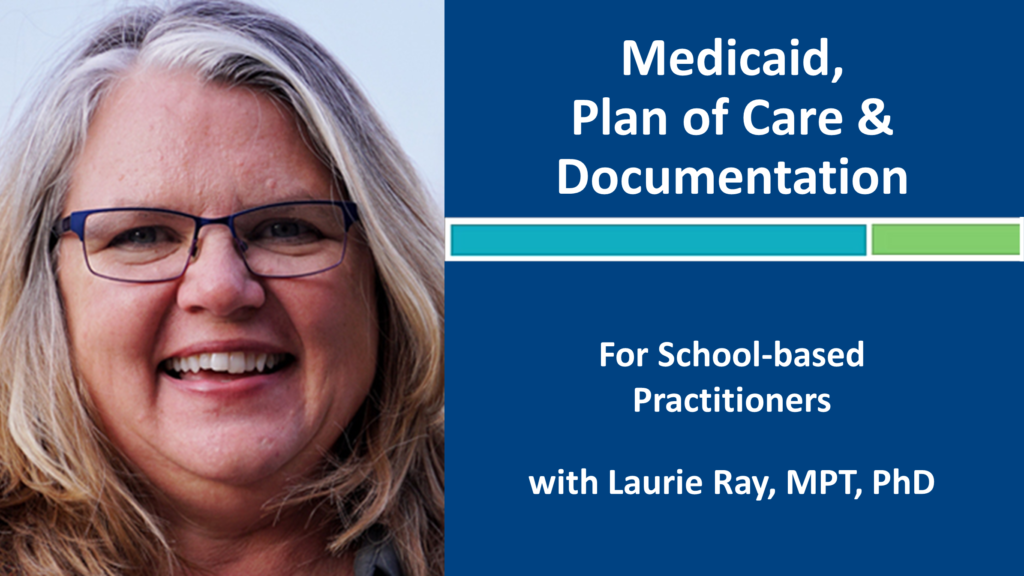
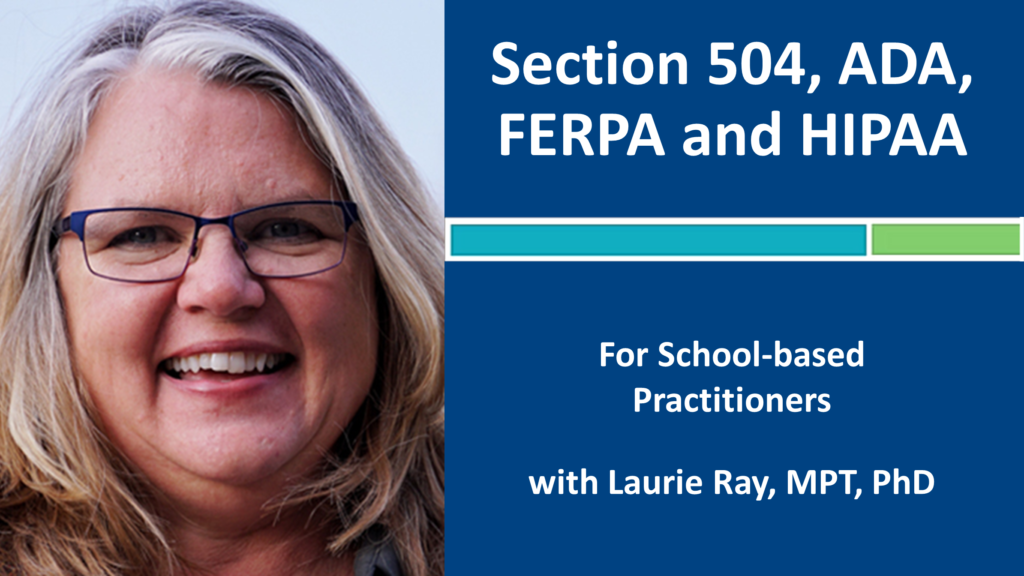
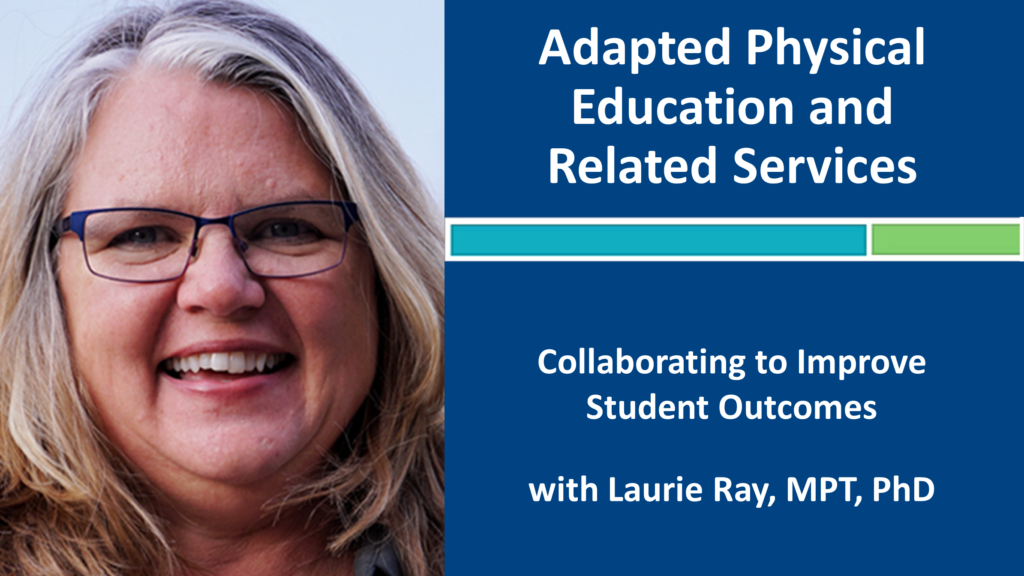
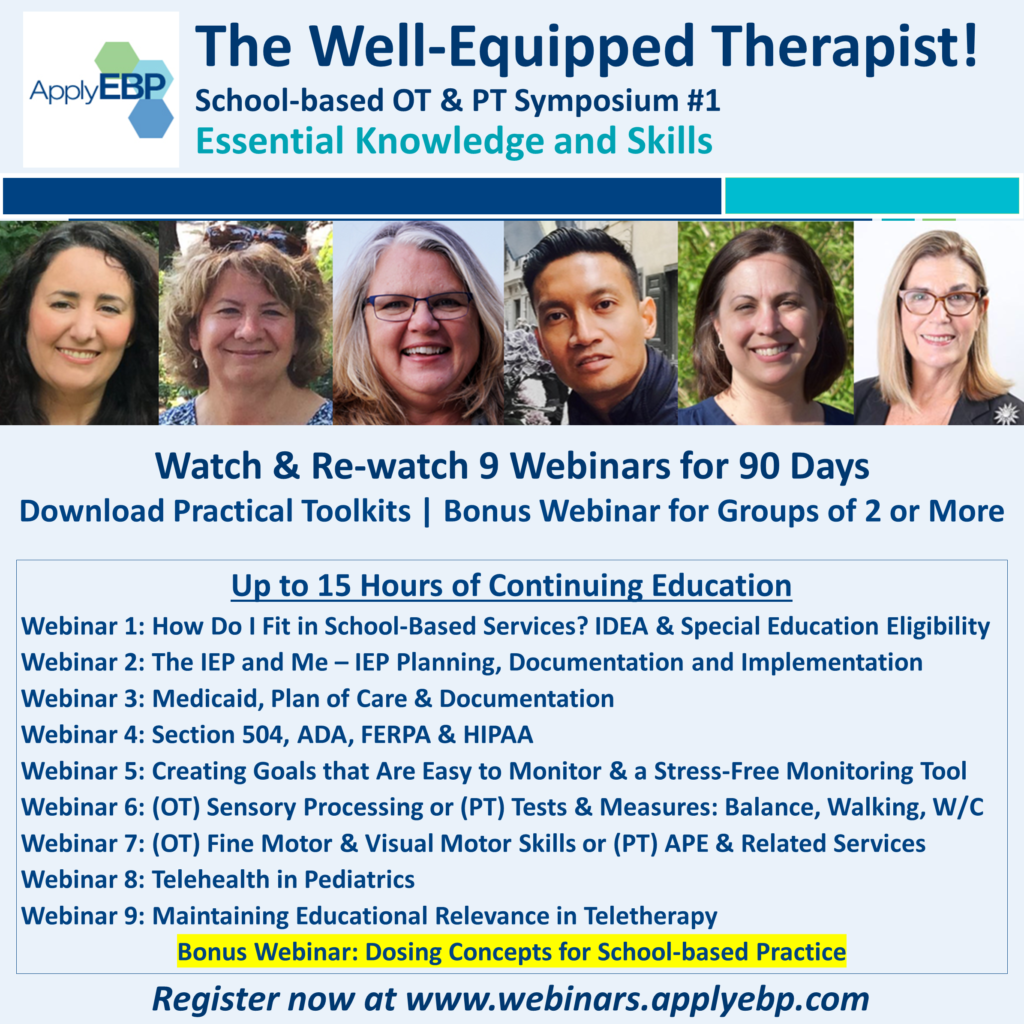
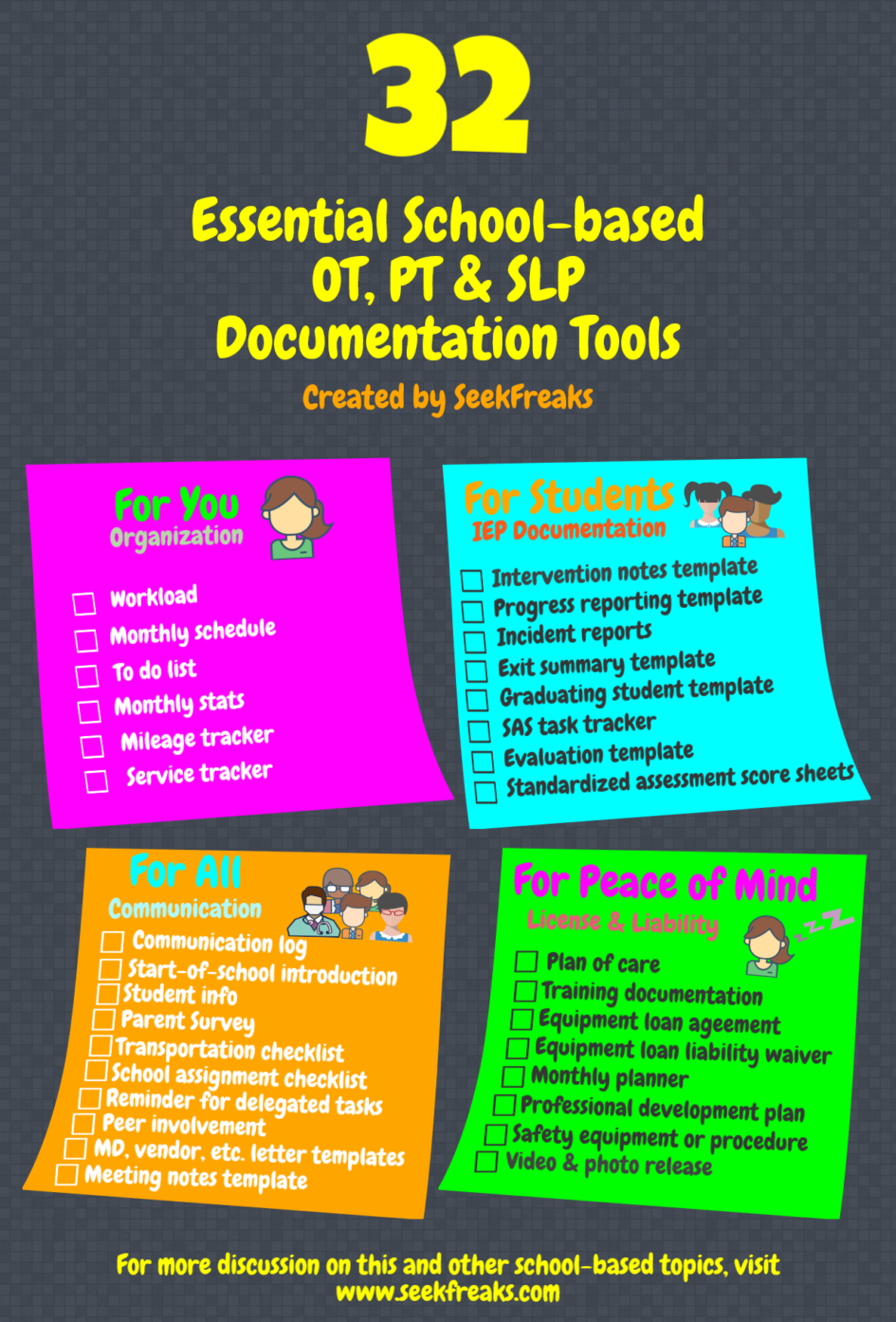












August 25, 2016 at 11:37 am
Thanks for the nice review, Laurie! Will you be sharing any of your goggle templates/documents or just don’t I see them? Nancy
August 25, 2016 at 10:39 pm
Hi Nancy,
Thank you! I am so glad you found this helpful. We do have plans to share templates but need to work out a technicality. They will come out bit by bit.
So glad for your interest!
Regards,
Laurie
August 25, 2016 at 5:21 pm
My new goal for this year will be to write up a few “peer-delegated tasks.” I have done many verbally, but never a written reminder as I have done for staff. Great idea.
August 25, 2016 at 10:56 pm
I found them really helpful to keep ALL students engaged. The peer helpers also prompted me to change the tasks with greater frequency.
Come back and leave a comment about how they worked?
Thank you for your comments!
September 2, 2016 at 4:12 pm
Thanks so much for sharing. I have shared the seekfreaks.com site with staff in our District. Looking forward to some of the templates/document examples. Best regards, Lois
August 24, 2017 at 3:11 pm
Yes! I am also looking for some document and template examples. They would really be a big help! Thanks for the review. Sounds like a great conference-Angela
November 14, 2018 at 7:14 pm
Hi – How can I download or purchase any of these documents?
Thank you,
Cheryl
September 23, 2019 at 4:58 pm
Hi.
I was wondering if you have templates for the various forms of documentation that you list on your home page?
Thank you!
November 22, 2019 at 2:48 pm
Love the info, are there templates available?
March 22, 2023 at 12:52 pm
Thank you for the information! I am new to the school-based PT sector and am wondering if any of these templates are available?